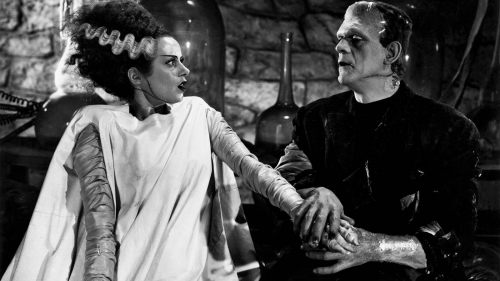THE BABADOOK, Actually, Is Gay
The internet is taking a moment this week amid its confetti-storm of Pride celebrations to revisit a beloved masterpiece of queer cinema, Jennifer Kent’s The Babadook (2014).
The film is the story of a bereaved family coming to terms with their new tenant – a shambling, screeching storybook demon who lives under the stairs and, once given name or thought, can never be exorcised: “If it’s in a word, or it’s in a book / You can’t get rid of the Babadook!” He is gay.
It has come to our attention, however, that the heterosexual community, in their usual loud and baffled way, is somewhat mystified by this icon of LGBT culture. What is so queer, wonders the average straight person (a very average creature indeed), about the hapless misadventures of Mister Babadook?
“DO you HAVE to say everything that goes through your mind?!?” Amelia Vanek (played by Essie Davis) bellows at her outspoken son, Samuel (Noah Wiseman), after his bad behaviour mortifies her for the dozenth time. Tempted though we might be to bellow the same here at this impudent dismissal of one of our community’s most cherished representations (including slanderous accusations now circulating that the meme began as a simple Netflix mis-sorting into the LGBT category), in the spirit of conciliation between our divided peoples, we thought it best we make it clear.
In fact, the Babadook explains for himself rather ably in his own radical queer manifesto, which he leaves with the Vaneks in the form of a red pop-up storybook and which, after Amelia cruelly censors its contents and shreds, he carefully reassembles and thoughtfully leaves, with new amendments, on their front porch (the Babadook, like all good gays, lives for maximum drama and thrives at arts and crafts): “Oh come!” He invites, in the benevolent spirit of allyship, “Come see what’s underneath!!” This new edition of his book, too, is met with censure, and, in the usual custom of straight people dealing with ideas or persons they do not understand, it is promptly burnt.
This act of silencing, however, is precisely what gives the Babadook his power, and makes him so legendary a queer icon.
His pop-up zine (the preferred communiqué of all goth queer artists) makes further friendly overtures: “I’ll wager with you, I’ll make you a bet! / The more you deny, the stronger I get!” It has been, we learn, seven years since the traumatic night Amelia lost her husband in a car accident and gave birth to her under-loved son – a child held hostage by his mother’s post-partum resentment at his noisy, irrepressible reminders of her bereavement, and who now lashes out. “Samuel already feels so different,” we are told, and like his father – and so unlike his mother – he always speaks his mind.
The Babadook – in his shapeless coat and shabby top hat, a signifier of her son and lost husband’s shared love of magic, and a fashion statement piece that has inspired the “stovepipe nightmare daddy” gay subculture – then, is the embodied, croaking shape of that grief. He is the unspeakable, the manifestation of the undealt-with, the unprocessed, the liminal: the terror that dare not speak its name, a monster come crawling from the locked cellar (where Amelia seals her dead husband’s things), hiding under the bed, and (not too subtly) bursting forth, in fabulous sinister crescendo like a guncle resplendent, from the closet.
The Babadook’s “threat” is disclosure, his name – ba ba DOOK DOOK DOOK! – becoming literally the sound of an insistent knock of truth at the door, demanding to “LET ME IN!” The great horror he visits on Amelia (who impolitely screams “It’s not REAL!” throughout) is a dreadful sexy striptease – hat hurled down the chimney, coat thrown sensuously to the floor – to reveal what’s underneath (Kent’s soundtrack here is an eldritch croaking wail building to a soul-rending cacophony; she evidently requested “I Am What I Am” from La Cage, but could not clear the rights in Australia).
Amelia, like most straight people, does not want to deal with what’s underneath. She watches TV and is disturbed by the Big Bad Wolf’s threat to the little pigs’ domestic bliss and his sheep’s skin disguise, is disturbed to see the Phantom of the Opera unmasked, is disturbed to hear other mothers offer bromides about her loss. In the world the Babadook has come to rescue the Vaneks from, heterosexuality is about locking things up, closing them away, medicating children into a stupor and casually murdering dogs I guess and tucking troublesome books above the wardrobe (my mom’s version of the “Mister Babadook” book was called “Marvin Redpost: Is He a Girl??!” and involved a gender-swapping elbow-kiss but that’s a conversation for my therapist).
But thanks to the Babadook, the quintessential makeover queen – all five queer eyes rolled into one – Amelia must confront the rot that has infested her life. Recognizing the disgrace of doling out grotesque ice cream bowls and passing them off as her son’s dinner (Ted did nutrition), she moves the fridge to find cockroaches scurrying from a hole (home reno – that was Thom), she reaches into her own mouth and plucks out a tooth, rotten and aching (grooming was beautiful, beautiful Kyan), and, when at last she is ready to face her crippling secret and move on, once the pile of clothes and top hat that enshrouds her life finally fall away (Carson), seven years of ignored heartache come pouring from her mouth as a torrent of horrible black bile – better out than in, the visceral restaging of dreadful relief that is the quintessence of every coming out experience (Jai did like personal improvement or whatever, but unlike Jai the Babadook actually does something and is less dead behind the eyes).
Some gay critics have complained that this trope of a bedraggled single mother getting an image adjustment from her gay bestie and her cute rambunctious kid is hackneyed and trite (it is in fact very similar to another classic of gay cinema, John Candy’s Uncle Buck), but what makes The Bababook such an enduring classic is the real lifelong friendship and new model family they forge.
Amelia learns her embodied grief may be ugly, may not be the life she wanted, but it is part of her narrative. The Babadook, like his lesbian counterpart Mary Poppins, may seem severe in his methods, but he teaches the family he saves how to let the sunlight in. “My husband died the day my son was born,” she finally manages to say, unflinchingly, finally speaking her mind as forthrightly as her son, and in her garden - as a shot tracks from below the soil - roses bloom.
And the Babadook now lives downstairs, where she visits once a day, and feeds him worms, and assures him it’s all right. The depression and terror of disclosure are not gone, but they can be faced, can be spoken with and soothed. He’s here; he’s queer; she’s used to him.
So happy Pride, Mister Babadook!

(Babadook Pride art by @melongifts)



